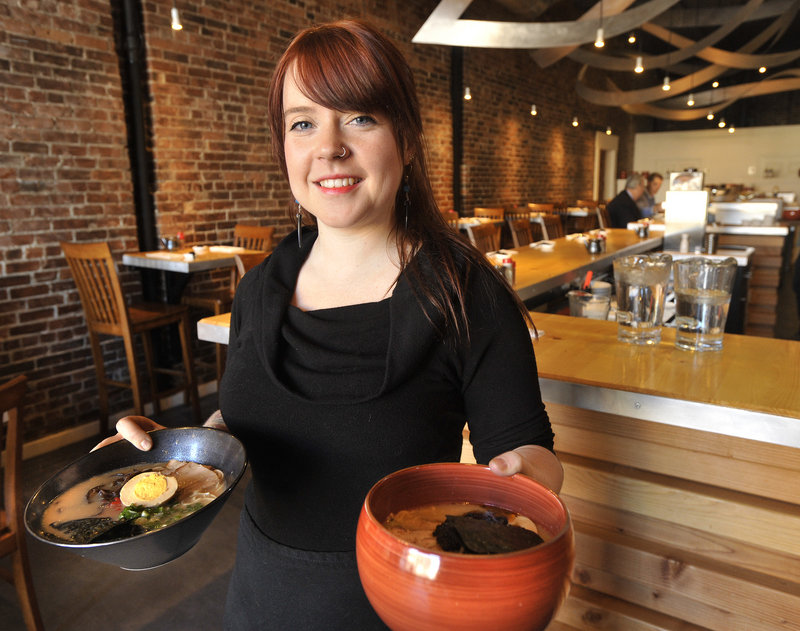This story was updated at 1 p.m. Dec. 20 to correct a description of the restaurant’s hot drinks. It does not serve coffee.
Pai Men Miyake opened to an onslaught of customers and attention a few months ago, and all the excitement made it a challenge to wait out the allotted time that’s always observed for new restaurants before visiting for a review dinner.
A calm, tranquil and experienced pleasure awaited us when we did. Pai Men has clearly found its way to delicious meals (at least with the stuff on the short menu that I tasted), and its friendly, quick servers took care of us with aplomb.
Addressing an emergency of raging appetites, a server who showed us to our table took an immediate order for pork buns and gyoza (pork dumplings). It was good luck that both appeared while my dinner companion was off in the restroom, allowing me to wolf much of both down in peace. And both were good.
Gyoza ($6), stuffed generously with chopped pork and cabbage, showed off golden-brown crescents of thin, perfectly pleated wonton wrapper that were fried deeply on one side and tender on the other. A shallow bowl of dipping sauce gave the light touch of soy sauce and Mirin vinegar, and let the pork flavor ring.
But the pork buns ($9) were best of the two. They had fatty pork belly with a crisp browned edge sandwiched in a soft, neutral rice-flour bun with copious amounts of Gochujang mayonnaise and seasoned with fermented chili paste.
Thin-sliced sour pickles cut the fat, but a lettuce leaf seemed extraneous. And if I did the arranging, I would put the same size slice of pork into each of three smaller steamed buns, to let the pork dominate each bite.
Squash dumpling appetizer ($8) with ground pork, miso and Rinkosan vinegar is an appetizer on a new menu.
Once we started to feel human again, we could appreciate the gorgeous interior: one wall of exposed brick and the opposite wall lined with end-grain, reddish wood blocks set at curving depths. Far above us, swooping metal sculptures presented an abstract expression of the heating pipes and ventilation ducts.
The sake expert wasn’t around so we didn’t hear much about the 16 sakes listed, and relied on printed descriptions.
Smaller bottles were 330 milliliters — a little less than a cup and a half, and the same size as half a bottle of wine. With an alcohol content of around 15 percent, that equals three generous glasses of wine. Another sake called Ai No Hime, “Princess of Love” ($16), is 187 milliliters, or about 3/4 of a cup.
If you go to the bottom of the page, you’ll find the least expensive 330 milliliter bottles to get your mouth started on rice wine. Or try the standby Gekkikian ($6) served hot, something American Japanese restaurants trained us to like and now want us to abandon, because only poor quality sake is served that way.
For $15, you can try three 1.5-ounce glasses of different sakes, an even better way to inch past that hot sake habit.
Or stick to the good wine, the best of three reds at $8 a glass being Italo Pietrantonj Montepulciano d’Abruzzo or the whites, like Henri Bourgeois Sauvignon blanc ($7 a glass, $28 a bottle).
Unagi don ($10) made my night, with an oblong of tender, savory eel; a soft, almost liquid poached egg; the utterly fantastic pearly sushi rice called Kagayaki; and slivers of scallion. The eel is farmed and shipped frozen from Japan by True World Foods and marinated here.
Spicy miso ($11) from the ramen list gave perfect satisfaction. A half of a hard-boiled egg marinated in soy added some salty protein, and spicy sesame garlic paste revved up the miso broth to the savory thickness and intensity of a kind of Japanese meat glaze. Tons of skinny ramen noodles filled the bowl in which a couple of thick slices of pork belly provided bites of mild and tender meat.
Konbu dashi ($11), broth made with dried kelp and holding tofu, sprouts, shiitake mushrooms and “wavy” noodles, is the vegetarian offering, with vegetarian starters including sauted choy ($7) with garlic and chili, the deep green leaves chewy and magnificent with heat, and cucumber salad that you could request not include dried baby anchovies.
But otherwise the menu is meat-happy for all of us carnivores re-inspired by winter’s cold to eat animals. Raw beef salad ($11) mixes sliced steak with daikon radish, yuzu jalapeno dressing and peanuts.
Congee is another new item, a Japanese rice porridge with littleneck clams, scallions and shimieji mushrooms.
The other ramen broths (all $9) — tonkotsu made with pork, miso made with chicken and pork, and shoyo made with dashi and chicken — vary the ramen bowls.
No dessert is served, another Japanese tradition Americans might consider getting used to. With the wonders of broth and noodles, pork belly and garlic and chili paste, it’s no sacrifice at all.
N.L. English is a Portland freelance writer and the author of “Chow Maine: The Best Restaurants, Cafes, Lobster Shacks and Markets on the Coast.” Visit English’s website, www.chowmaineguide.com.
Send questions/comments to the editors.


